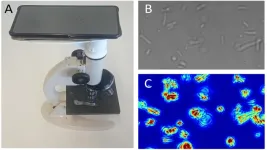(Press-News.org) Ohio University Professor of Physiology and Executive Director of the Ohio Musculoskeletal and Neurological Institute (OMNI) Brian Clark Ph.D. was one of 40 expert leaders in the field of aging from around the world chosen to present at a workshop hosted by the National Institute of Health’s (NIH) National Institute on Aging (NIA) on the development of function promoting therapies for age-related weakness. Clark was also asked by the NIH to publish a comprehensive review of his research over the past decade in the Journal of Gerontology.
The workshop covered a variety of topics including advances in muscle biology, novel candidate molecules, findings from randomized trials, and challenges in the design of clinical trials and regulatory approval of function-promoting therapies.
“It’s always an honor to give a talk at this type of workshop and major meeting such as this,” Clark said. “You cherish these moments because you have put your life into this research and are able to capture an audience of key people working in the same discipline. Sharing my knowledge and findings on this type of platform also allows for a broader impact and critical discussions to take place.”
During the workshop, Clark spoke about his research on the role of the nervous system in age-related muscle weakness and participated on a panel discussion about the correlation between neural mechanisms and age-related loss of muscle strength.
Much of what he spoke about during the workshop was also included in the article in the Journal of Gerontology which detailed his work evaluating the putative neural mechanisms of age-related muscle weakness, promoting therapies for age-related mobility limitations.
The article also discusses the evolving definition of sarcopenia, or the gradual loss of muscle mass, strength, and function, and its primary defining characteristic – weakness. The review article explores the premise that impairments in the nervous system’s ability to generate maximal force of power contribute to sarcopenia.
“Understanding the causes of age-related losses of physical function has implications to both patients, in relation to improved health, physical capacity, quality of life and more, as well as society at large, as there are a large number of older adults who require assistance with daily tasks due to weakness,” Clark said. “By understanding the causes of weakness and physical function loss we can develop rationale therapeutic strategies.”
Clark added that some therapeutic strategies include the development of therapeutic compounds, nutraceuticals and supplements, diet and exercise. He explained that to improve strength and function, we must first understand what causes weakness.
According to Clark, when he was a graduate student more than 25 years ago and first getting into this field of study, it was largely assumed that age-related weakness and loss of mobility were due to a person’s muscles wasting away. That despite best efforts, weakness was just a part of aging. However, after years of research, Clark has found that age-related weakness is also related to the nervous system changes and the physical performance of muscles.
“Muscles are puppets being moved by the nervous system,” Clark explained. “We have found robust evidence in our lab showing how age-related changes happen due to how well the brain signals move the muscles to work or in how well the muscles act on that signal.”
According to Clark, the specific neural mechanisms appear to be linked to low level nerve cell excitability, impaired ability to transmit action potentials/electrical signals between the nerves and the muscles, as well as reduced integrity of brain networks involved in performing relatively automatic motor tasks, such as walking.
The findings from Clark’s lab identifies some potential therapeutic targets, as well as helps to underscore the need for exercise and physical to maintain muscle strength and function with aging. In particular, resistance exercises that strengthen muscles and tasks and exercises that challenge motor control, such as dancing, are vitally important.
“Our work has consistently indicated that changes in the nervous system are a key culprit and likely account for about a third of the weakness seen in aging, in addition to the loss of muscle mass and quality,” Clark said.
Assisting Clark in his research are a vast network of collaborators from over the years, including students and colleagues at OHIO. In particular, Clark notes that his wife, Leatha Clark who holds degrees in engineering mechanics as well as a Doctor in Physical Therapy, has been integral to the work done his lab. He also notes that Todd Manini, a professor at the University of Florida, who he has worked with since they were graduate students together at Syracuse University, and who happens to be an OHIO alumni (BS ’97, Biological Sciences), is a critical collaborator of his. More recently, Clark notes that he has developed a very robust and strong collaboration with Dave Arnold, M.D., executive director of the NextGen Precision Health initiative at the University of Missouri.
Currently, Clark, who is also the Osteopathic Heritage Foundation Harold E. Clybourne, D.O., Endowed Research Chair, is working to identify the role of the motor neuron, the final neuron that connects the nervous system with the muscle, in health and disease. He is also working to develop novel tools for diagnosing sarcopenia and osteoporosis. These projects are funded by around $10 million in grants from the NIH.
END
Brian Clark selected to speak, presented discoveries at NIH workshop and in Journal of Gerontology
2023-04-24
ELSE PRESS RELEASES FROM THIS DATE:
Increased risk of Alzheimer's disease due to exposure to polycyclic aromatic hydrocarbons
2023-04-24
Polycyclic aromatic hydrocarbons (PAHs) are typical organic compounds found in cigarette smoke and vehicle exhaust. In addition, PAHs are produced from incomplete combustion of organic material and cooking. The highest concentrations of PM-bound PAHs ranged from 550 ng/m3 to 39000 ng/m3, were observed in Chinese kitchens, fire stations, and ships. Polycyclic aromatic hydrocarbons may combine with ultrafine particles (UFPs) in the air to form particle-bound PAHs. PM0.1 may adsorb large amounts of toxic organic compounds, and long-term exposure to indoor UFPs from cooking resulted in ...
This gel stops brain tumors in mice. Could it offer hope for humans?
2023-04-24
Medication delivered by a novel gel cured 100% of mice with an aggressive brain cancer, a striking result that offers new hope for patients diagnosed with glioblastoma, one of the deadliest and most common brain tumors in humans.
“Despite recent technological advancements, there is a dire need for new treatment strategies,” said Honggang Cui, a Johns Hopkins University chemical and biomolecular engineer who led the research. “We think this hydrogel will be the future and will supplement current treatments for brain cancer.”
Cui’s team combined an anticancer drug and ...
New tools capture economic benefit of restoring urban streams
2023-04-24
An interdisciplinary team of researchers has developed a suite of tools to estimate the total economic value of improving water quality in urban streams. The work can assist federal and state agencies charged with developing environmental regulations affecting urban ecosystems across the Piedmont Region of the United States, which stretches from Maryland to Alabama.
“Urban streams are ubiquitous and face a number of stressors from rapid economic development,” says Roger von Haefen, professor of agricultural and resource economics at North Carolina State University and corresponding ...
A blinking fish reveals clues as to how our ancestors evolved from water to land
2023-04-24
UNIVERSITY PARK, Pa. — An unusual blinking fish, the mudskipper, spends much of the day out of the water and is providing clues as to how and why blinking might have evolved during the transition to life on land in our own ancestors. New research shows that these amphibious fish have evolved a blinking behavior that serves many of the same purposes of our blinking. The results suggest that blinking may be among the suite of traits that evolved to allow the transition to life on land in tetrapods — the group of animals that includes mammals, birds, reptiles and amphibians — some 375 million years ago.
The study appears the week ...
New machine-learning method predicts body clock timing to improve sleep and health decisions
2023-04-24
A new machine-learning method could help us gauge the time of our internal body clock, helping us all make better health decisions, including when and how long to sleep.
The research, which has been conducted by the University of Surrey and the University of Groningen, used a machine learning programme to analyse metabolites in blood to predict the time of our internal circadian timing system.
To date the standard method to determine the timing of the circadian system is to measure the timing of our ...
Health surveys, studies exclude trans people and gender-diverse communities, impacting health care
2023-04-24
ANN ARBOR—Health surveys and clinical studies have a data collection problem: Because of the way they record sex or gender, they often exclude transgender and gender-diverse people, according to University of Michigan research.
Most studies and surveys either ask participants for their sex, a biological construct, or their gender, a social construct. In this way, they only consider either sex or gender independently or use the two concepts interchangeably, says Kate Duchowny, a research assistant professor in the Survey Research Center at the U-M Institute for Social Research.
Participants either respond with their sex assigned at birth or the ...
Scientists detect seismic waves traveling through Martian core for the first time
2023-04-24
Scientists observed seismic waves traveling through Mars’ core for the first time and confirmed model predictions of the core’s composition.
An international research team—which included University of Maryland seismologists—used seismic data acquired by the NASA InSight lander to directly measure properties of Mars’s core, finding a completely liquid iron-alloy core with high percentages of sulfur and oxygen. Published in the Proceedings of the National Academy of Sciences on April 24, 2023, these findings reveal new insights into how Mars formed and geological differences ...
Pioneering research sheds new light on the origins and composition of planet Mars
2023-04-24
A new study has uncovered intriguing insights into the liquid core at the centre of Mars, furthering understanding of the planet’s formation and evolution.
The research, led by the University of Bristol and published in the journal Proceedings of the National Academy of Sciences of the US, reveals the first-ever detections of sound waves travelling into the Martian core. Measurements from this acoustic energy, called seismic waves, indicate its liquid core is slightly denser and smaller than previously thought, and comprises a mixture of iron and numerous other elements.
The ...
Testing antibiotic resistance with a fast, cheap, and easy method
2023-04-24
“We have developed a technique in our laboratories that allows us to obtain an antibiogram within 2-4 hours – instead of the current 24 hours for the most common germs and one month for tuberculosis,” says Dr Sandor Kasas at EPFL. Professor Ronnie Willaert at Vrije Universiteit Brussel adds: “Our technique is not only faster but also simpler and much cheaper than all those existing now.”
Antibiotic resistance happens when bacteria develop the ability to defeat the drugs designed to kill them. It ...
Interfering with antiviral pathway may deter Alzheimer’s disease and frontotemporal dementia
2023-04-24
Targeting part of an antiviral pathway triggered by the accumulation of a key pathogen shared in Alzheimer’s disease and frontotemporal dementia may one day offer a new therapeutic approach to deterring or delaying cognitive decline, according to preclinical research led by Weill Cornell Medicine scientists.
The study, published April 24 in Nature Neuroscience, demonstrates that inhibiting an innate immune system enzyme called cyclic GMP–AMP synthase (cGAS) helps neurons become resilient to the build-up of the protein tau into bundles known as fibrils, a hallmark of Alzheimer’s and some forms of frontotemporal dementia, the two most ...





